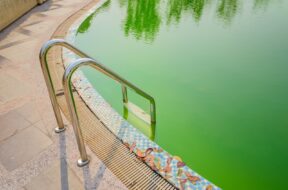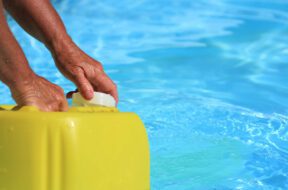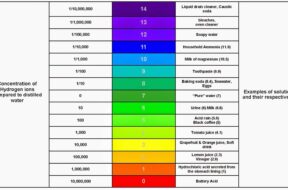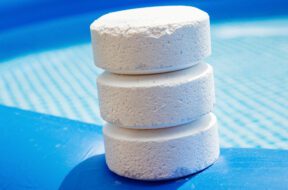
Want to learn more about algaecide? Read on to find out when to add algaecide to your pool maintenance routine and other helpful tips.
Free chlorine has a difficult time sanitizing contaminants as pH increases. Free chlorine should be maintained at 2 to 4 ppm and pH should be maintained at 7.4 to 7.6.
Although chlorine is the single most important component in terms of taking care of your pool, it is not independent from the other components of your pool water. The degree to which chlorine is effective in sanitizing your pool by breaking down contaminants is highly correlated to the degree to which pH is kept in balance.
In this article, we dive into the relationship between chlorine and pH, and how pH of water changes the effectiveness of chlorine. You may also want to learn about The Relationship Between Pool Chlorine and Cyanuric Acid.
Chlorine is a naturally occurring chemical in nature, with atomic number 17. The most common form of chlorine is sodium chloride, which you may remember from your high school chemistry days is table salt. Salt water pools are quite a common form of residential pool in which a salt water generator (SWG) breaks down the chloride in salt to sanitize the pool.
The key to how chlorine sanitizes pools lies in how it interacts with the water, itself. When chlorine is added to water, it forms a weak acid called hypochlorous acid. Because most bacteria cells, such as those found in E. coli, are negatively charged and hypochlorous acid is neutrally charged, the hypochlorous acid penetrates the bacteria and oxidize its protein cells, which breaks the bacteria down. It’s the combination of chlorine and water that kills harmful microorganisms commonly found in swimming pools.
The acronym pH stands for “potential Hydrogen’. The “p” is lower case so as not to be confused with the chemical symbol “P”, which stands for Phosphorus. The pH scale measures the acidity and basicity of chemical compounds from 0 to 14, where 0 is the most acidic and 14 is the most basic.
The scale is expressed in logarithmic terms. This means a compound with a pH of 7 should is 10 times more acidic than a compound with a pH of 8.
Recall that when chlorine is added to water, it interacts to form hypochlorous acid. Hypochlorous acid is what is responsible for killing contaminants in swimming pools and hot tubs. Hypochlorous acid should tip us off to the importance of the pH of the water. Because it is an acid that is responsible for killing harmful bacteria, it follows that the more acidic the water is, the better the conditions for hypochlorous acid to operate.
This is indeed the case. It turns out, that as the water becomes more basic, the compound(s) formed by mixing chlorine and the water change. At a pH of 5, hypochlorous acid is the only compound formed from the interaction between the chlorine and water. At a pH of 10, the only compounds formed from the interaction of chlorine and water are hypochlorite and hydroxide. Hypochlorous acid is 80-100 times more effective at fighting bacteria than hypochlorite. Hypochlorite is effectively useless at fighting bacteria in swimming pools.
The ideal pH of water to maximize chlorine’s ability to interact and form hypochlorous acid to kill off bacteria is anything less than 5. However, water with a pH of 5 would be very uncomfortable to swim in. It is also important to take into consideration of the corrosive effects water has on the pool surface.
What we really want to know is what is the ideal pH level that will maximize hypochlorous acid, but simultaneously minimize irritation to human skin and corrosion to pool surfaces. The Center for Disease Control has found the answer to be a pH of 7.45 and free chlorine of 3.0 ppm. The easiest way to check your pH and chlorine levels is with test strips. When your free chlorine levels get too low, we recommend using calcium hypochlorite to raise them back up.

Want to learn more about algaecide? Read on to find out when to add algaecide to your pool maintenance routine and other helpful tips.

In this quick guide, we’ll answer the question “can you over shock a pool” and unveil the factors to consider when shocking a pool.

Maintaining both pH and total alkalinity in your swimming pool is important for keeping your pool properly sanitized and non-corrosive. Total alkalinity is to pH what cyanuric acid is to free chlorine. Total alkalinity stabilizes pH levels. The ideal pool pH level is 7.4 to 7.6. The ideal total alkalinity level is 80 to 120 ppm.

The Association of Pool and Spa Professionals recommends free chlorine levels for both swimming pools and hot tubs be kept between 2.0 and 4.0 ppm. However, the Center for Disease Control recommends free chlorine stay above 1 ppm in pools and 3 ppm in hot tubs.